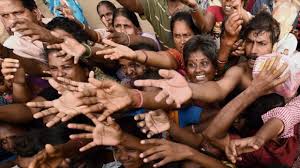

Data Doesn’t Lie: Where Dalits Suffer Most in India
On October 7, 2025, a tragic incident in Uttar Pradesh’s Raebareli district highlights the continuing crisis of Dalit atrocities in India. This article delves into the State-Wise Dalit Atrocities Trends in India, analyzing the states with the highest and lowest burdens of crimes against Scheduled Castes, and exploring why these injustices persist.
State-Wise Dalit Atrocities Trends: High-Burden States
India registered 57,789 cases of crimes against Scheduled Castes (SCs) in 2023 under various heads, according to the National Crime Records Bureau (NCRB). Uttar Pradesh led this count, reporting 15,130 cases, which was the highest among all states. Closely behind came Rajasthan with 8,449 cases, Madhya Pradesh with 8,232, and Bihar with 7,064. These four states alone accounted for a very large share of such crimes. Meanwhile, states like West Bengal recorded only 102 cases, translating to a rate of about 0.5 per lakh population — among the lowest in the country. The Economic Times
In the previous year, 2022, the government reported 51,656 cases of atrocities against SCs under the Scheduled Castes and Scheduled Tribes (Prevention of Atrocities) Act. Uttar Pradesh registered 12,287 cases, which amounted to about 23.78% of all cases nationally. Rajasthan followed with 8,651 (16.75%), Madhya Pradesh with 7,732 (14.97%), Bihar with 6,799 (13.16%), Odisha with 3,576 (6.93%), and Maharashtra with 2,706 (5.24%). These six states together accounted for nearly 81% of all atrocities against SCs across India in 2022. The Indian Express
Thus, a small set of states repeatedly record very large numbers of crimes against Dalits, while several others report much lower numbers. The discrepancy suggests both variation in actual incidence and differences in reporting, social awareness, police responsiveness, and possibly population size.
Low‑Incidence States and What the Data Suggests
While the high‑burden states dominate national figures, some states report notably fewer crimes against SCs. For example, in 2023, West Bengal’s 102 registered cases stood out as especially low given its large population. Similarly, states with smaller SC populations or more dispersed rural communities often report fewer cases, though under‑reporting cannot be ruled out.
In many of these low‑incidence states, the rate of crimes per lakh SC population remains low. That suggests either better social integration, stronger local policing or community oversight, more effective rights awareness, or simply fewer reported incidents due to fear or social pressures. Yet, low numbers do not always mean safety; they often mask gaps in legal recourse, awareness, and protection mechanisms.
Charge‑sheeting rates and final report closures also vary across states. While some states manage to file charge‑sheets in a high proportion of cases, others lag behind, making it difficult for many victims to see justice. For example, in 2023, overall charge‑sheet filing for crimes against SCs stood at about 81.2%, but in states such as Rajasthan and Jharkhand, the rate remained under 50%.
Implications and the Way Forward
The data shows that crimes against SCs heavily concentrate in certain states, especially Uttar Pradesh, Rajasthan, Madhya Pradesh, and Bihar. These states not only report high absolute numbers but often have higher crime rates per SC population. Meanwhile, states like West Bengal, or smaller states with lower SC populations, report much fewer incidents. This contrast reveals that both systemic factors and local governance matter a great deal.

A seasoned journalist with over 30 years of rich and diverse experience in print and electronic media, Prabha’s professional stints include working with Sahara English Magazine, Pioneer and JAIN TV and All India Radio. She has also been writing in Pioneer. She has also produced several documentary films through her self-owned production house Gajpati Communications. She is also the Station Director of Aligarh-based FM Radio Station, and the General Secretary of WADA NGO.






